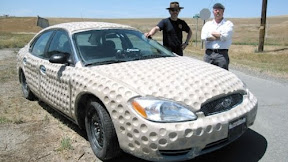On a recent episode of the TV show MythBusters, special effects experts Adam Savage and Jamie Hyneman ran tests to see if a dirty car is more fuel efficient than a clean one. It turned out that dirt doesn’t make a difference to the mileage (in fact it reduced mileage by ~1.5 mpg). But the intrepid experimenters didn’t stop there. They went a step further to test if covering a car in actual golf ball-like dimples would improve its fuel efficiency?
As seen in the video below, dimpled golf balls could fly almost twice as far as smooth balls, since they disrupt the air around them, which creates a smaller wake and reduces drag. So could the same principle could really be applied to race cars?
To answer the question, the Mythbusters team went about adding 1,082 dimples to a Ford Taurus’s exterior. To keep the experiment consistent, all 1,082 dimples removed from the clay exterior were put in a box and then set in the back seat so that the car would weigh exactly the same as before dimpling.

At constant 65 mph speed, the cleaner car gave 26 MPG and the dimpled one gave an amazing 29 MPG. The theory or the improvement is that, like a golf ball, the dimples would reduce the car’s drag through the air, thus allowing it to travel the same distance at the same speed using less fuel.

So, in a difficult economy with high fuel prices, a dimpled car design can very well save you some cash. In fact, an improvement of 3 MPG translates into ~$400-600 per year of savings for the average person who drives 15,000 miles.
If you have the interest to find out more, you can view the full video of MythBusters Mileage Test.
